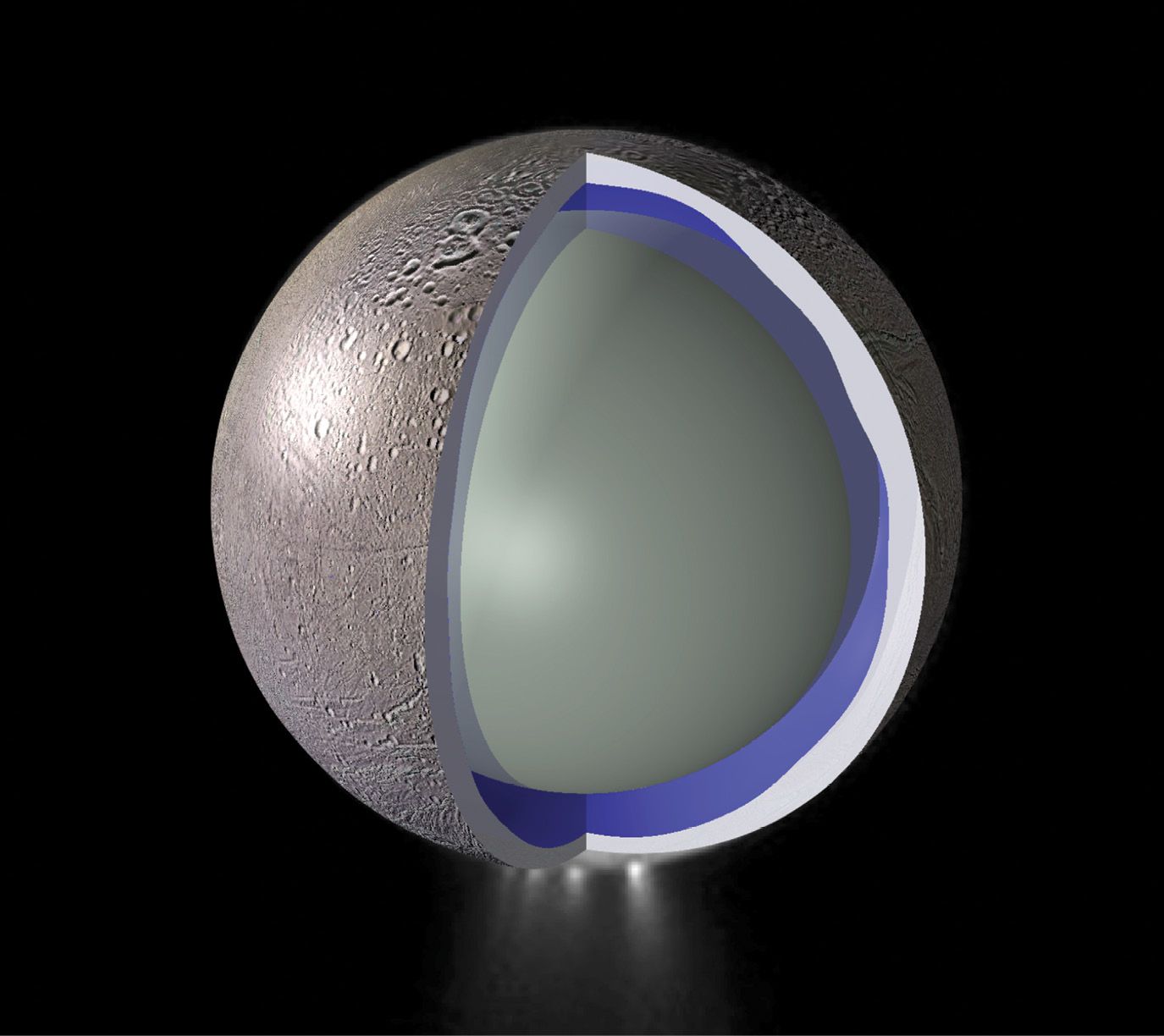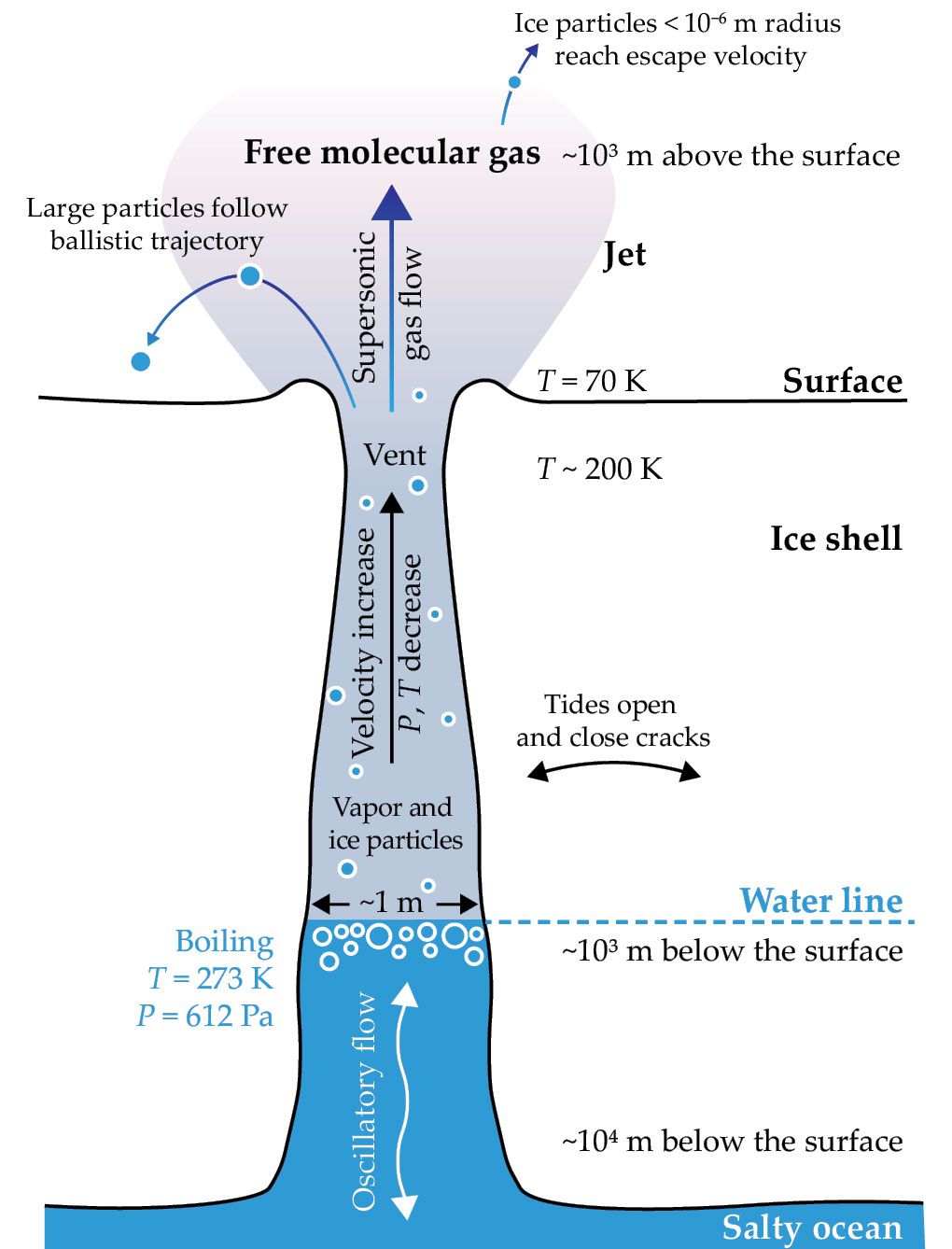Enceladus erupts
DOI: 10.1063/PT.3.5165
One of the most exciting discoveries in planetary science of the past few decades is the eruption of water from Enceladus, a small ice-covered moon of Saturn. Ice particles and vapor are ejected. Some of the ice falls back to the surface as snow, making Enceladus one of the most reflective objects in our solar system. Smaller ice particles not only feed the E ring of Saturn, but with the vapor, they also provide a window into the structure and dynamics of Enceladus’s interior, including its rocky core, a potentially habitable liquid-water ocean, and the fissures through which the water erupts.
The sources of the eruptions are a set of fissures near the south pole of Enceladus. Properties of the erupted materials have been characterized by a host of instruments on the Cassini spacecraft, which explored Saturn and its moons between 2004 and 2017. (See the article by John Spencer, Physics Today, November 2011, page 38
Shell game
Although researchers initially debated whether the eruptions come from a body of liquid water or from the decomposition of gas-bearing ices in the ice shell, the presence of salts in the ice grains and silica nanoparticles indicates a source from an ocean in contact with a rocky core. The presence of a global ocean under Enceladus’s ice shell is confirmed by gravity and shape measurements and the amplitude of the ice shell’s tidal oscillations. The eruptions thus appear to be sourced from an internal ocean, shown in figure
Figure 1.

Enceladus in cross section. In addition to the craters that scar its icy surface, Enceladus contains smooth plains and cracks, ridges, and fissures. The moon’s interior is composed of an ice shell (white), whose thickness is roughly 20 km on average but thins at the south pole, as modeled from gravity measurements. Below that shell is an ocean (blue) that covers a rocky interior (gray). (Courtesy of Doug Hemingway.)

The presence of active water eruptions on a small (250 km radius) body in the cold outer solar system raises several questions: How is it warm enough to sustain a liquid ocean? What makes the cracks that enable eruptions? Why doesn’t water freeze in the cracks? Why are the fissures only at the south pole? Those questions remain open research topics. Even so, we favor some intuitive explanations.
Enceladus orbits Saturn twice during each orbit of Dione, another of the planet’s satellites. The orbital resonance forces Enceladus into an elliptical orbit, which in turn causes cyclic tidal deformation. Dissipated heat from that deformation keeps the interior warm enough to maintain an ocean. The same tidal dissipation inside water-filled cracks can help keep the water from freezing.
The presence of the ocean itself may cause those cracks to form in the first place because of feedback between Enceladus’s orbit and the tidal dissipation of heat. When the dissipation decreases, the ice shell thickens. The increase in the volume of liquid water as it freezes onto the ice shell’s base compresses the ocean and stretches the overlying shell. If the stresses from the stretching become large enough, a crack can form.
Gravity on Enceladus is weak, and pressures remain sufficiently low throughout the ice shell that cracks could penetrate the entire shell. They form at the south pole where the ice shell is thinnest and the combination of heating from tidal deformation in the ice shell and the ocean circulation is highest.
Eruption mechanics
The processes governing the eruption of water vary with depth and altitude (see figure
Figure 2.

Shell dynamics. This schematic (not to scale) illustrates some of the main processes that occur inside the ice shell and its fissures. The eruptions are assumed to originate from water in an ocean under the shell, although any liquid-water source, such as a melt reservoir in the icy crust, should produce similar dynamics. As Enceladus’s tidal forces open and close a crack in the fissure, water flows into (and recedes from) the fissure. The velocities of ascending vapor and ice particles increase in the vent as pressures and temperatures drop. Above the vent, they reach supersonic speed.

As a first approximation, the flow of gas and ice in the fissures can be treated as being close to adiabatic—meaning that energy is only transferred to the surroundings as work—if two conditions are met. First, the flow must be sufficiently rapid that the exchange of heat with the fissure walls can be neglected. Second, erupted particles and gas must remain in thermodynamic equilibrium, and the vapor, liquid, and solids all move at the same velocity.
As the flow ascends, it decompresses and cools. Water vapor condenses on ice particles and nucleates new particles, creating a mixture of particles and gas. The velocity of the flow at the vent is likely limited by the sound speed of the two-phase mixture because the pressure gradient becomes infinite as velocity approaches the speed of sound.
The back pressure exerted by the mixture moving through the fissure and vent limits the rate of vaporization and the total mass flux from the eruptions. Above the surface of Enceladus, the erupting mixture forms a jet as it expands into space at velocities that become supersonic. With continued expansion, the mean free path of gas molecules grows too large for further condensation. As the plume becomes increasingly dilute, it turns optically thin and no longer expands with constant entropy as heat radiates to space.
In the fissure and just above the vent, the smallest ice particles can be accelerated by the expanding gas to reach escape velocities; larger particles reach lower speeds, follow ballistic trajectories, and fall back to the surface of Enceladus.
Physicists are less certain about what happens in the moon’s interior, including whether liquid water can be generated in the ice shell and, hence, whether the eruptions need to originate from the ocean. Knowing the compositions of the ocean and erupted gases and particles is especially important to assess the habitability of the interior ocean and interpret possible biosignatures. Open questions also remain about the geometry of the eruptions and fissures, the longevity of the eruptions, how they are modulated by tides, and why they are at the south pole.
The proposed Enceladus Orbilander mission, which would collect fresh plume material from orbit and send a lander to gather samples from the surface, is one of two large missions prioritized in the 2023–32 Planetary Science and Astrobiology Decadal Survey. A new generation of instrumentation will be better able to probe the geochemical and physical processes that sustain the eruptions, assess the habitability of the ocean, and search for evidence of past or current life in the erupted materials.
The authors are grateful for support from NASA.
References
► C. C. Porco et al., “Cassini observes the active south pole of Enceladus,” Science 311, 1393 (2006). https://doi.org/10.1126/science.1123013
► P. M. Schenk et al., eds., Enceladus and the Icy Moons of Saturn, U. Arizona Press (2018).
► M. Nakajima, A. P. Ingersoll, “Controlled boiling on Enceladus. 1. Model of the vapor-driven jets,” Icarus 272, 309 (2016). https://doi.org/10.1016/j.icarus.2016.02.027
► E. S. Kite, A. M. Rubin, “Sustained eruptions on Enceladus explained by turbulent dissipation in tiger stripes,” Proc. Natl. Acad. Sci. USA 113, 3972 (2016). https://doi.org/10.1073/pnas.1520507113
► D. J. Hemingway, M. L. Rudolph, M. Manga, “Cascading parallel fractures on Enceladus,” Nat. Astron. 4, 234 (2019). https://doi.org/10.1038/s41550-019-0958-x
More about the Authors
Michael Manga is a professor and the department chair of Earth and planetary science at the University of California, Berkeley, and Max Rudolph is an associate professor of Earth and planetary sciences at the University of California, Davis.


